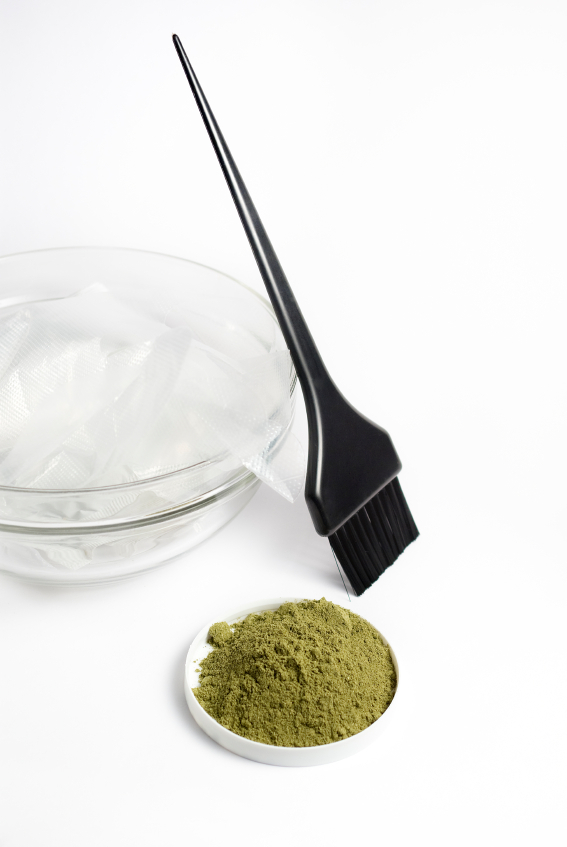Henna is a fantastic natural plant dye for achieving reddish tones that do not fade on the hair. Even though henna is basically one tone- orange-red, it can be mixed with other herbs such as Cassia to achieve lighter tones, such as gingers and coppers, and Indigo or Katam (aka buxus) for darker tones such as chestnut, mahogany, browns and blacks. Since henna is translucent, it will not lighten the hair. Of course, the best way to find your colour is to strand test (see below) before applying any henna mixture to your hair. Keep in mind that any henna, indigo or katam dye takes 3 days to fully develop after dyeing.
Strand testing
This is the most important step when it comes to dyeing the hair with henna. As henna looks different on different shades of hair, strand testing will give you a clearer idea of what to expect, and to see if your mixes are in fact what you’re looking for. To strand test, it is best to order samples of Henna and Cassia (for the lighter, coppery/strawberry blonde tones), henna alone (if you’re looking for rich ginger reds/copper reds/deep reds), or Henna and Katam/Indigo for the burgundy/browns/blacks. Of course, if you already have your henna, cassia/indigo, create your ideal mix on a much smaller scale, and let the henna dye release. Harvest some of your shed hair from your hair brush or the shower and keep your shed hair in for the necessary time. After the hair has been dyed, rinse gently with water, let dry and leave it alone for 2 days. After the two days is up, assess the colour. If the colour is too dark, adjust the time or henna/cassia or henna/katam(organic indigo)/indigo ratio. If the colour is too light, perhaps leave the mixture in the hair for longer. If the hair is still too light even after leaving the test hair in the henna for a lengthy period of time, re-dye the sample for an extra hour or two and let oxidise for 2 days to see if your desired colour has been achieved.
Following are some recipes to achieve colours from strawberry blondes to reds. For burgundy and black tones, please stay tuned for the second part of this article: Basic Henna Recipes: From Red to Black.
Light Copper/Strawberry Blonde
Light copper shows best on all blonde tones and light brown or hair tones. For a light copper or tone, mix either Moroccan or Jamila henna with cassia at a ratio of 10/90. For strawberry blonde tones, use the same ratio with Yemeni or Red Raj. Mix the Henna and cassia together with Chamomile tea or catnip tea (Hibiscus tea for strawberry blonde) and a drizzle of honey. Leave on for approximately 1 hour. On medium brown- dark brown, these mixes appears more like light copper pennies/strawberry blonde that is less evident the darker the hair is. In the sun, on darker hair, this mix leaves a light coppery/strawberry blonde shimmery tint in the sun/bright light on darker hair. On black hair, this tone will show a faint coppery shimmer/strawberry blonde in the sun only. Repeat applications may not be necessary to achieve this tone. **(See root applications).
Medium Copper/Copper Penny
This blend gives copper penny tones on medium blondes to medium brown hair tones. For this mix, use Jamila or Moroccan Henna (or a blend of both!) with cassia at a 30/70 ratio mixed with any herbal tea such as chamomile or hibiscus. Leave the mix on the hair for approximately 1.5-2.5 hours and up to 3 hours. Repeat applications may not be necessary to achieve this tone. **(See root applications). In dark hair, this mix gives a transparent coppery sheen.
Pure Henna
From copper penny-burgundy how to.
Tones from dark ginger all the way to burgundy can be achieved with pure henna depending on the time the henna paste is left on the hair and how many applications of henna are layered over each other. With henna on its own, the colour is richer and slightly deeper than with cassia blends. For copper penny tones, leave the henna on for an hour, max and use hibiscus, plain water, water with a splash of lemon juice or Apple cider vinegar or chamomile tea for the liquid.
Perfect henna powders to achieve this tone are Moroccan and Yemeni (or a blend of both). As the colour oxidizes, the tone may match that of a copper penny. For dark ginger reds, leave the Henna on the hair for 2-3 hours. The best henna for dark ginger reds is Jamila henna powder. These tones may not require a repeat application, so root touch ups are essential to keep the colour as bright and as light as you prefer.
For a deeper red, leave the henna on for at least 4 hours. For burgundy, leave on over night, or repeat the henna application until the desired colour is reached, then proceed with lengthy root applications. As mentioned earlier, henna most definitely depends on your natural hair colour, so don’t expect to go a light coppery tone if you have very dark hair. If you have blonde- medium brown hair, the colour will be a vivid reddish tone (more vivid red on lighter hair, dark red on darker hair that is vivid in the sunlight). On black hair, henna may not be noticable at all until you go out in the sun. This is where repeat applications come in. henna is translucent, so more layers of henna build up over each other to create a stronger colour that will eventually give black hair the burgundy-black sheen.
Be sure to follow our blog and read “Basic Henna Recipes: From Burgundy To Black” which includes hair recipes for burgundy, browns and black tones including root application tips.



















Thank you! you have excellent information on using henna, in fact, the best I have seen so far. I would like to know some nice combinations for salt and pepper hair, using primarily Cassea.
Hello, I have a question in regards to getting a henna/cassia/alma recipe. I have naturally dirty dishwater blonde hair and want to get a nice brownish red color. Like a dirty dishwater strawberry blonde color. Can you recommend ratios? Thank you!
Hi
I used a chestnut henna and my hair has turned black!
I want my natural light brown hair back, please advise…
Regards,
Hello,
I thought I read on your site not to use Lemon Juice as it is drying?
I am sorry..either I am tired or thick but when you say 10/90 is the henna 10 and cassia 90? thanks
For a light strawberry blond it would be 10% henna and 90% cassia. Is this the recipe you were speaking of, Kitten?
I have been searching for best henna mixture for my hair but I am more confused than ever. My hair color is something between medium brown and medium chestnut. I have no dye on my hair, and no grays either. But for some reason, the roots seem in lighter color than the ends. I want to achieve medium copper. I bought pure cassia and pure henna and I was going to apply 7 to 3 ratio. But now I am confused that it will not give me the results that I look for. Any advice?
Btw, even though every hair is different, it would be great to have some before-after pictures in different initial hair color to give an idea about what to expect from these recipes. So that we know what products to buy and then do the strand test.
Good day Esra. Thank you for posting on our blog. That ratio does sound like you would get a copper tone, but to push more of a medium copper you might need more henna like 6 to 4.
Yes we agree more photos would be great. We’ll try to start a photo library of that 🙂
Hi,
I used to go to a hairdresser for years to have my hair dyed. My natural hair color is dark to medium brown with a bit of graying starting. My dayed hair is medium copper color, but dry, broken and demaged. I am looking for a narural alternative to restore my hear. Reading about henna, sounds the answer to me. Could you please guide me how to do it myself? I have read about the mixture of henna and cassia for a ginger copper and also adding janila and/or moroccan to henna. Is it realistic for me to aim for a light copper tone using natural plant like henna? Please could you give me some advice? Many thanks,
Dominique